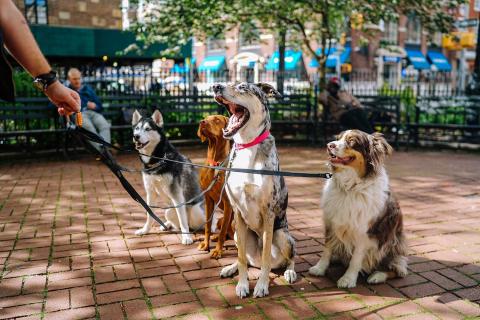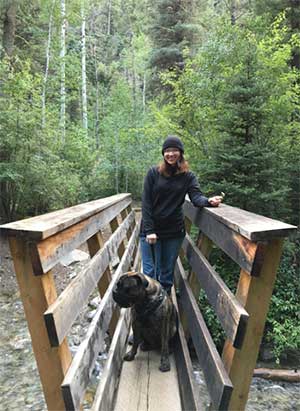*Please note I am not a dog training expert; however, I have years of experience in caring and training dogs, including extra-large breeds (over 100lbs)

While owning a dog provides immense joy, the bond between you and your pal strengthens by mastering essential commands, creating an even more gratifying relationship. Dogs’ love and loyalty are immeasurable as they are pack animals and long to have a sense of belonging among the family. For their safety and yours, however, it is necessary to teach them several basic commands, which they can follow on your cue. February is Dog Training Education Month which reminds us to spend time teaching our dogs essential training tips. National Dog Day on August 26th is another run day to spend time practicing the following essential training tips.
1. Sit
A basic starting point for any dog. this command is easiest to manage by practicing on the leash and graduating to off the leash after successful comprehension, especially during puppyhood. Place the leash under your heel with enough slack for your dog to complete the command.
Start out holding a treat near his nose. From there, arch your hand above his head, toward his back. Your dog will look up, tilting his head back, and direct his bottom downward. If he doesn’t, push his bottom down gently with one hand and say “sit.“ Reward him with a treat and praise him with love. Repeat, repeat, repeat until you can say the command with no need for treats.
2. Lay
This is a submissive stance and might be more challenging to teach yet still necessary. After your dog has mastered the sit command, cup a treat in the palm of your hand and have him sit. Move your cupped hand towards his nose, so he can sniff it; then lower your hand from his nose, past his chest, to the floor. He will follow the treat with his nose and lower his body to the ground. Give the command “lay.” Similar to the sit command, reward, praise, and repeat.
3. Up
While your dog is lying, hold a treat in one hand, and with the other hand, snap your fingers and raise your hand and give the command “up.” This is a simple command to teach as he is eager to transition from that submissive position.
4. Stay
Once you have taught the previous commands, this is the next step. This command will test their patience and probably yours. With your dog in the sit position, place a treat in your cupped hand and allow him to sniff it. Say the word “stay” and take one to two-steps backward. Maintaining eye contact, position your empty hand in the stop-sign formation and repeat the word “stay” with each step backward. Try to take three or four steps back; then reward him with a treat. Repeat this process and increase your distance.
The stop motion is helpful as it becomes a cue later when later no treats are available; he will respond to the hand signal.
5. Come
This command is accomplished consecutively with stay. Have your dog sit and stay, increasing the distance between you and him. Once he stays in place without running toward you, kneel and give the command “come.” This is another easy command to teach as he is ready for the treat and your affection.
6. Place
Comparable to the sit command, this too is best managed on the leash first; the leash allows you to navigate your dog. Start by standing near his bed or crate. With a treat in one hand and leash in the other, move him to his bed and give the command “place,” providing a treat when he is there and sitting. Praise and repeat this process until a leash is unnecessary.
7. Heel
Heel is a vital command when walking your dog. A dog who constantly lunges and tugs on the leash can be exhausting and frustrating. Decide which side (right or left) your dog is going to walk on and always remain consistent. Depending on which side you choose, hold the leash with whatever hand feels more comfortable and natural for you. Keep your leash hand at navel height, to aid in control but do not grip the leash too tight as he can sense tension and become hyper-alert.
When you begin to walk, your dog should walk next to you. If he tugs, give the command “heel” and pull back on the leash. As he responds, reward him with a treat. If he does not respond and continues lunging, have him sit and relax before continuing on your walk. Each time he lunges, stop, make him sit, reward him, and begin again. He will eventually grow weary, giving in to your commands, and allow you to resume teaching him to heel.
8. Leave-it
This command is imperative for your dog’s safety, preventing him from eating unwanted substances. Ask your dog to sit while you hold out your cupped hand with a treat in it, letting him sniff it. Place your cupped hand on the floor in front of him while giving the command “leave-it”. He will try to paw at your hand but tell him “no” in a firm voice as you retract your cupped hand. Repeat this process, telling him to “leave-it” each time, until he learns to wait. Reward him and proceed to the next step.
Place your open palm with a treat in front of him on the floor giving the command “leave-it.” If he darts for the treat, say “no” and quickly close your hand to prevent him from getting the treat. Continue this until he stops trying to snatch the treat and waits. Reward him and follow up with the final step.
Place the treat on the floor in front of him and slowly back away while repeating “leave-it.” He should be watching you for the cue and no longer starring at the treat. Continue to practice with increased distance between you and him with the treat.
9. Drop-it
Practice this command with his favorite ball, frisbee, or rope. Give the command “drop-it” and remove the toy from his mouth. Reward him with a treat. Continue to practice this over and over until he willingly gives you the toy. He will learn to drop the toy as you replace it for a tasty treat.
Always use positive reinforcement - love, praise, and treats - to reward your dog for a job well done. If you or your dog are becoming frustrated while trying to teach these commands, take a break and resume in a few hours. You want your dog to enjoy the learning opportunity and bonding experience.
Consistency is the key component to training your dog. If he seems to not get it on the first few tries, don’t quit. Keep practicing, and in time, he will understand your request and follow-through, making you a proud owner. Practicing these skills generates an unbreakable bond between the two of you, deepening his sense of loyalty towards you.
Perhaps you and your dog need an instructor-model approach to training. With Dog Training Education Month in February, use this as a time to sign up for obedience classes or hire a personal trainer. They can help provide additional guidance and support to work with you and train your dog.
*Please note I am not a dog training expert; however, I have years of experience in caring and training dogs, including extra-large breeds (over 100lbs)
